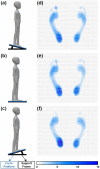Dynamical Analysis of Standing Balance Control on Sloped Surfaces in Individuals with Lumbar Disc Herniation
- PMID: 32015370
- PMCID: PMC6997405
- DOI: 10.1038/s41598-020-58455-z
Dynamical Analysis of Standing Balance Control on Sloped Surfaces in Individuals with Lumbar Disc Herniation
Abstract
The changes of balance control mechanism caused by lumbar disc herniation (LDH) has not been well understood. This study aimed to investigate the effects of LDH on the balance control during standing on sloped surfaces. Ten patients with LDH and 10 gender- and age-matched healthy subjects were instructed to stand quietly on a sloped surface at -5°, 0° or +5°, respectively. The trajectories of the center of pressure (COP) of each individual limb and the full-body were recorded. Cross recurrence quantification analysis (CRQA) was applied to assess the coordination of COP components at the anterior-posterior and medial-lateral directions. The patients with LDH presented magnified inter-limb load asymmetry and had more deterministic components in the COP coordination of the less-affected limb and the full-body than the healthy subjects. The LDH led to decreased dynamical degree of freedom and less flexibility in bidirectional controlling the center of mass simultaneously. The effects of sensorimotor deficits due to LDH could be more obviously exhibited as standing on a declined rather than an inclined surface. This study shed light on the effects of LDH on standing balance control and may facilitate to develop novel strategies for evaluation of LDH.
Conflict of interest statement
The authors declare no competing interests.
Figures





Similar articles
-
Analysis of Standing Balance on Sloped Surfaces in Individuals with Lumbar Disc Herniation.Annu Int Conf IEEE Eng Med Biol Soc. 2019 Jul;2019:5092-5095. doi: 10.1109/EMBC.2019.8857918. Annu Int Conf IEEE Eng Med Biol Soc. 2019. PMID: 31947004
-
Sagittal balance parameters correlate with spinal conformational type and MRI changes in lumbar degenerative disc disease: results of a retrospective study.Eur J Orthop Surg Traumatol. 2016 Oct;26(7):735-43. doi: 10.1007/s00590-016-1842-3. Epub 2016 Aug 25. Eur J Orthop Surg Traumatol. 2016. PMID: 27562589
-
Asymmetry between the superior and inferior endplates is a risk factor for lumbar disc degeneration.J Orthop Res. 2018 Sep;36(9):2469-2475. doi: 10.1002/jor.23906. Epub 2018 Apr 25. J Orthop Res. 2018. PMID: 29611881
-
Lumbar disc herniation with contralateral radiculopathy: a systematic review on pathophysiology and surgical strategies.Neurosurg Rev. 2021 Apr;44(2):1071-1081. doi: 10.1007/s10143-020-01294-3. Epub 2020 Apr 13. Neurosurg Rev. 2021. PMID: 32281018
-
Lumbar Disc Herniation with Contralateral Symptoms: A Case-Series of 11 Patients and Literature Review.Orthop Surg. 2023 Nov;15(11):2839-2847. doi: 10.1111/os.13849. Epub 2023 Sep 25. Orthop Surg. 2023. PMID: 37749774 Free PMC article. Review.
Cited by
-
Changes in Motor Strategy and Neuromuscular Control During Balance Tasks in People with a Bimalleolar Ankle Fracture: A Preliminary and Exploratory Study.Sensors (Basel). 2024 Oct 23;24(21):6798. doi: 10.3390/s24216798. Sensors (Basel). 2024. PMID: 39517697 Free PMC article.
-
Dynamical network-based evaluation for neuromuscular dysfunction in stroke-induced hemiplegia during standing.J Neuroeng Rehabil. 2024 Oct 24;21(1):190. doi: 10.1186/s12984-024-01488-6. J Neuroeng Rehabil. 2024. PMID: 39449006 Free PMC article.
-
Predictive Factors for Residual Low Back Pain Following Percutaneous Endoscopic Lumbar Discectomy in Patients with Lumbar Disc Herniation.Med Sci Monit. 2024 Jan 6;30:e942231. doi: 10.12659/MSM.942231. Med Sci Monit. 2024. PMID: 38183217 Free PMC article.
-
Clinical significance of dynamical network indices of surface electromyography for reticular neuromuscular control assessment.J Neuroeng Rehabil. 2023 Dec 20;20(1):170. doi: 10.1186/s12984-023-01297-3. J Neuroeng Rehabil. 2023. PMID: 38124144 Free PMC article.
-
Neuromuscular conditions in post-stroke ankle-foot dysfunction reflected by surface electromyography.J Neuroeng Rehabil. 2024 Aug 7;21(1):137. doi: 10.1186/s12984-024-01435-5. J Neuroeng Rehabil. 2024. PMID: 39107804 Free PMC article.
References
-
- Diener, H. C. & Dichgans, J. In Progress in Brain Research Vol. 76 (eds eds Pompeiano, O. & Allum, J. H. J.) 253–262 (Elsevier, 1988). - PubMed
Publication types
MeSH terms
Supplementary concepts
LinkOut - more resources
Full Text Sources
Medical

